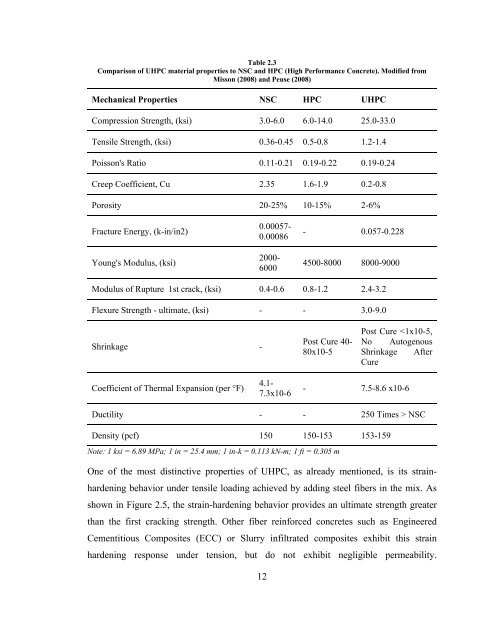- Page 1 and 2: COMPATIBILITY OF ULTRA HIGH PERFORM
- Page 3 and 4: Table of ContentsList of Figures ..
- Page 5 and 6: 4.3.2 Discussion ..................
- Page 7 and 8: Figure 3.14 CSP index .............
- Page 9 and 10: Table 4.7 Summary of indirect tensi
- Page 11 and 12: List of AbbreviationsACI.AFtASTM.CO
- Page 13 and 14: 1 Introduction and MotivationCurren
- Page 15: 2 Background and Literature ReviewT
- Page 18 and 19: spaces and to decrease the amount o
- Page 20 and 21: water/binder=constantChoose steel f
- Page 22 and 23: UHPC formulations and provides a se
- Page 26 and 27: esults obtained in this project wer
- Page 28 and 29: 2.1.3.4 Environmental Impact of UHP
- Page 30 and 31: 1997). Emmons and Vaysburd (1996) d
- Page 32 and 33: e) ConstructabilityIt is recommenda
- Page 34 and 35: Table 2.5, continuedCementitious ma
- Page 36 and 37: • Rehabilitation of a bridge pier
- Page 38 and 39: UHPC is a cost-effective solution i
- Page 40 and 41: apparatus will measure the shear st
- Page 42 and 43: substrate while the scarifying meth
- Page 44 and 45: such test configuration, this upper
- Page 46 and 47: From the equilibrium of forces of F
- Page 48 and 49: The first layer, also called penetr
- Page 50 and 51: 3 MethodologyThis report aims to st
- Page 52 and 53: f sp = 2 ∗ PA ∗ π in psi Equat
- Page 54 and 55: that the bond interface, in this lo
- Page 56 and 57: Ductal® premix is typically compri
- Page 58 and 59: associated test results (temperatur
- Page 60 and 61: Figure 3.2 Detail of splitting tens
- Page 62 and 63: 3.3.3 Pull-off testPull off test wa
- Page 64 and 65: (a) Chipped surface, slightlybrushe
- Page 66 and 67: (a) Molds to cast slant shearspecim
- Page 68 and 69: Timber moulds were used to cast the
- Page 70 and 71: macrotexture depth was measured in
- Page 72 and 73: As shown in the above tables, the m
- Page 74 and 75:
(a) Concrete substrate under water
- Page 76 and 77:
used, as shown in Figure 3.17. A fa
- Page 78 and 79:
Equation 2.2 and Equation 2.3 were
- Page 80 and 81:
(a) Steel disks glued to the UHPC s
- Page 82 and 83:
value to the lowest one in the foll
- Page 84 and 85:
Transversal frequency (Hz)255025002
- Page 86 and 87:
115113Relative Dynamic Modulus (%)1
- Page 88 and 89:
Only those specimens with a grooved
- Page 90 and 91:
Table 4.6, continued.MeanMeanCOV,st
- Page 92 and 93:
concrete or bond/concrete while for
- Page 94 and 95:
surface treatment applied. In contr
- Page 96 and 97:
Table 4.8Summary of slant-shear tes
- Page 98 and 99:
(a) B(C): Bond due to concrete fail
- Page 100 and 101:
3143Bond Capacity, (psi)30002500200
- Page 102 and 103:
The different failure modes obtaine
- Page 104 and 105:
failures occurred in the concrete s
- Page 106 and 107:
property of the concrete has higher
- Page 108 and 109:
5.1.1 Combination of Splitting Tens
- Page 110 and 111:
5.1.4 Overall performancea. For thi
- Page 112 and 113:
mismatch and load eccentricity. Tho
- Page 114 and 115:
6 ReferenceAbu-Tair, A. I., Rigden,
- Page 116 and 117:
Climaco, J. C. T. S., and Regan, P.
- Page 118 and 119:
Graybeal, B., and Tanesi, J. (2007)
- Page 120 and 121:
Misson, D. (2008). "Influence of Cu
- Page 122 and 123:
Silfwerbrand, J. (1990). "Improving
- Page 124 and 125:
7 Appendix: NSC mix designsTable 7.
- Page 126 and 127:
Table 7.33rd mix for the splitting
- Page 128 and 129:
Table 7.51st mix for the splitting
- Page 130 and 131:
Table 7.73rd mix for the splitting
- Page 132 and 133:
Figure 8.2 Concrete retarder inform
- Page 134 and 135:
Table 9.1, continued.BrBr w/oBr 300
- Page 136 and 137:
Table 9.2, continued.TrialBrushed 6
- Page 138 and 139:
10 Appendix: Splitting tensile pris
- Page 140 and 141:
Table 10.1, continued.128
- Page 142 and 143:
Table 10.1, continued.130
- Page 144 and 145:
Table 10.1, continued.132
- Page 146 and 147:
Table 10.1, continued.134
- Page 148 and 149:
Table 10.2Splitting monolithic NSC
- Page 150 and 151:
11 Appendix: Slant-shear specimens
- Page 152 and 153:
Table 11.1, continued.140
- Page 154 and 155:
Table 12.1, continued.142
- Page 156 and 157:
PortionNumberof 1figures/tables/ill
- Page 158 and 159:
Figure 2.5Miguel Angel Carbonell Mu
- Page 160 and 161:
Miguel Angel Carbonell Munoz Mon, M
- Page 162 and 163:
Miguel - not sure what you need fro
- Page 164 and 165:
End Page 1235Type of UsePortionNumb
- Page 166 and 167:
Type of UseIntended publisher of ot
















